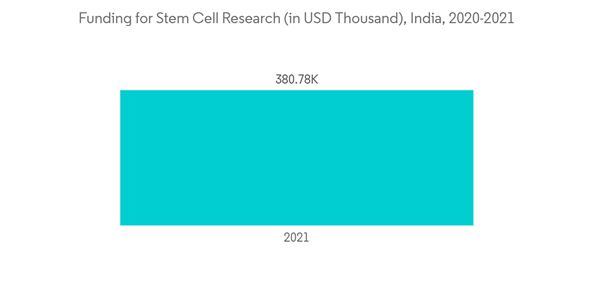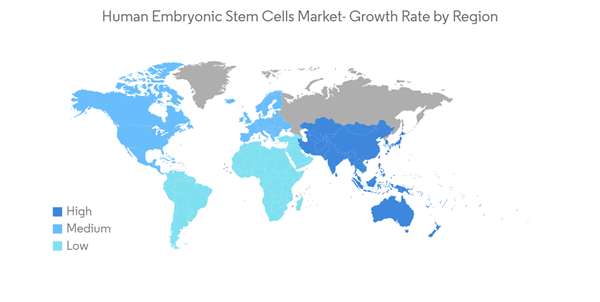The human embryonic stem cell market is expected to witness a CAGR of 9.29% over the forecast period.
This product will be delivered within 2 business days.
Key Highlights
- The COVID-19 pandemic had a significant impact on the growth of the market, which was majorly due to the rising number of clinical trials and the growing research on stem cell therapies for effective management of COVID-19 infection. In the context of COVID-19, government organizations in various countries, research institutes, and many biotech and pharmaceutical firms were focusing on effective and rapid technologies for the fast diagnosis and treatment of COVID-19.
- For instance, according to a research article from PubMed published in April 2020, it was found that mesenchymal stem cells are safe and effective for the treatment of COVID-19. Mesenchymal Stem Cells (MSCs)-based immunomodulation treatment has been proposed as a suitable therapeutic approach. The positive results from such studies led to the development of new therapies for COVID-19 and thus propelled the growth of the market. Currently, the market has reached its pre-pandemic nature and is expected to witness strong growth in the coming years.
- The growth of the market is attributed to the high prevalence of cardiac and malignant diseases, rising demand for regenerative medicines, and increasing support from government and private institutions.
- Government funding for the development of regenerative medicine has been increasing in most developed countries, owing to its applications in organ transplantation, tissue engineering, and various other applications. For instance, in June 2021, The Australian Government boosted stem cell research through USD 25 million in grants to help find and develop innovative, safe, and effective treatments for serious diseases and injuries.
- The area of human embryonic stem cell-based therapies garners significant investments, and various clinical trials that require considerable support for expenditure are currently underway. Companies are fundraising to develop stem cell-based therapies to tackle many diseases. For instance, in January 2022, Cellino Biotech, a cell therapy manufacturing company, raised USD 80 million in a Series A financing round. Cellino plans to expand access to stem cell-based therapies by building the first autonomous human cell foundry in 2025.
- Additionally, other factors, such as the high prevalence of cardiac and malignant diseases and the rising demand for regenerative medicines, are expected to drive the market. According to the data published by the European Heart Network in 2021, in the European Union, more than 60 million people live with Cardiovascular disease, and close to 13 million new cases of cardiovascular diseases are diagnosed every year. Such incidences of cardiac diseases are expected to drive the demand for effective therapeutics, such as embryonic stem cell therapies, thereby contributing to the growth of the market.
- Thus, owing to the abovementioned factors, the market is expected to project significant growth over the forecast period. However, the high cost of the procedure and stringent regulatory scenario are expected to restrain the growth of the market over the forecast period.
Human Embryonic Stem Cells Market Trends
Stem Cell Biology Research Segment is Expected to Show Better Growth in the Forecast Year
- Stem cells are biological cells that can differentiate into other types of cells. Additionally, various types of stem cells are used for therapeutic purposes. With multiple applications at the clinical stage for various diseases such as cancer and neurological conditions, these have been explored extensively by many biopharmaceutical companies in recent times. Stem cell biology research will show better growth, owing to the high prevalence of diseases such as Parkinson's disease, cancer, and Others.
- The data from Parkinson's Foundation published in June 2022 stated that every year, around 90,000 people in the United States are diagnosed with Parkinson's Disease. According to the article from DVC Stem published in August 2022, it was observed that the goal of stem cell therapy for Parkinson's disease is to replace destroyed brain cells with healthy, undifferentiated stem cells.
- Furthermore, in September 2021, Tabar, a physician-scientist at Memorial Sloan Kettering Cancer Center in New York City, led a clinical trial to inject stem cells into the brains of people with Parkinson's disease to restore dopamine levels. Additionally, to accelerate stem cell research, the government is providing funding opportunities to researchers.
- For instance, the PubMed data published in February 2022 mentioned that the total funds released by the Indian Council of Medical Research (ICMR) under stem cell research in fellowships in 2021 were USD 3 million. Therefore, increasing research in the field of stem cells is boosting its adoption, which is contributing to the segment growth.
- Thus, owing to these factors, the market studied is expected to witness a high growth rate over the forecast period.
North America to Hold a Major Share in the Human Embryonic Stem Cells Market Over The Forecast Period
- North American region is expected to hold a significant share of the market studied owing to extensive research activities and the region's high burden of chronic diseases and genetic disorders. The United States also shows a high incidence of diabetes, heart disease, renal failure, and osteoporosis. Human embryonic stem cells have a high potential for use in treatment and may become a standard of care for these diseases. For instance, researchers are trying to use HESC to generate healthy replacement tissues and cells for various diseases and injuries such as heart disease, Parkinson's disease, spinal cord injuries, and diabetes.
- In April 2021, Vertex Pharmaceuticals Incorporated received the United States Food and Drug Administration (FDA) Fast Track Designation for VX-880, and the company initiated a clinical trial for VX-880 in patients who have type 1 diabetes (T1D) with severe hypoglycemia and impaired hypoglycemic awareness. VX-880 is one of the first investigational stem cell-derived therapies utilizing fully differentiated, insulin-producing pancreatic islet cells for the treatment of type 1 diabetes. Such increasing approvals are expected to drive the growth of the market.
- Also, the increasing research funding for the development of various therapies is expected to drive the growth of the market in this region. For instance, in May 2022, UBC Medicine researchers were awarded over USD 2.5 million from Canada's Stem Cell Network to advance six regenerative medicine research projects and clinical trials.
- Hence, these factors are expected to influence the growth of the human embryonic stem cells market over the forecast period.
Human Embryonic Stem Cells Industry Overview
The human embryonic stem cells market is moderately competitive due to the presence of several companies operating globally and regionally. The competitive landscape includes an analysis of a few international and local companies that hold market shares and are well known. The global players in the human embryonic stem cells market are Astellas Pharma Inc., PeproTech Inc., Lineage Cell Therapeutics Inc., Merck KGaA, PromoCell GmbH, STEMCELL Technologies Inc., Thermo Fisher Scientific, ViaCyte, Inc.Additional Benefits:
- The market estimate (ME) sheet in Excel format
- 3 months of analyst support
This product will be delivered within 2 business days.
Table of Contents
1 INTRODUCTION
4 MARKET DYNAMICS
5 MARKET SEGMENTATION (Market Size by Value - USD)
6 COMPETITIVE LANDSCAPE
Companies Mentioned (Partial List)
A selection of companies mentioned in this report includes, but is not limited to:
- Astellas Pharma Inc.
- PeproTech Inc.
- Lineage Cell Therapeutics Inc.
- Merck KGaA
- PromoCell GmbH
- STEMCELL Technologies Inc
- Thermo Fisher Scientific
- ViaCyte, Inc.
- Takara Bio Inc.
Methodology

LOADING...










